 Tank of the Month
Tank of the Month
Tank of the Month
Mike Cao's (uhuru) Reef Aquarium
 |
Introduction
Having been blown away by so many incredible reef systems featured in Reefkeeping Magazine and Reef Central’s Tank of the Month over the years, never did I imagine my own aquarium being in the same company. I am very happy to share my aquarium with the reef hobbyists around the world, and hope that this inspires readers to continue with advancing both the art and science involved in reefkeeping.
History
Like many, I started with freshwater aquariums as a kid. Even at 12 or 13 years old, I can remember managing multiple aquariums in the house, though my first attempt at a reef tank was unsuccessful. I took a long break through much of my adolescence. My re-entry into the hobby was inspired by a tiny 5 gallon pico tank I randomly saw on a website. As a college student, it seemed like a great idea to try something like that myself. Within a couple of months, I was setting up my own 5 gallon tank. The abundance of information on the internet with sites such as ReefCentral.com really helped me get back up to speed on current methods and technologies. Working with such small volumes of water in the past have helped me understand the basic concepts of water quality management since there is little room for error.
Non-Photosynthetics: Exploring the Unknown
When I moved to Ohio in 2008 for school, I knew I wanted to set up an aquarium but I was concerned with how much time and money I would have. My initial plan was just to set up a simple 20 gallon reef with easy to keep, low maintenance corals. However, I would visit the local fish store and kept finding myself being attracted to the section that housed non-photosynthetic (NPS) or azooxanthellae (azoox) corals. NPS, or azoox corals lack the necessary amount of zooxanthellae in their cells to sustain life through photosynthesis. This does not rule out the possibility that they house this symbiotic algae. In fact, recent research has shown that many of them do, even when living in dark areas of the reef. However, these animals rely on food capture to meet their metabolic demands. These poorly understood yet stunningly beautiful corals intrigued me, and my simple nano tank soon became an all out non-photosynthetic setup.
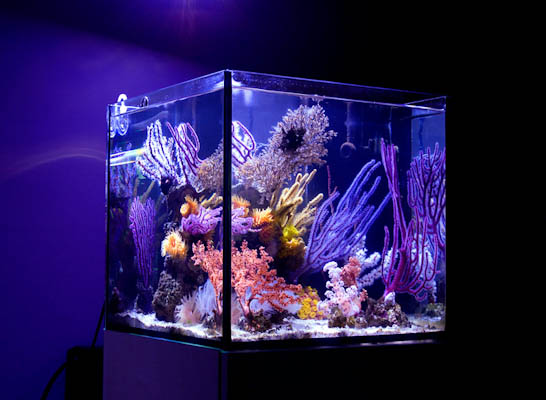 |
I experimented with a multitude of foods, feeding devices and maintenance routines. In the end, I found what worked: very heavy feeding, very aggressive filtration, daily water changes and lots of equipment upkeep. My tank was blossoming and full of life, but if I became too busy with school and started to slip a little bit in any part of the program, things would start to decline. In a relatively short amount of time I started to feel burnt out. I stopped enjoying my tank. With school becoming increasingly demanding, I knew I had to find another way to keep things going. By the end of 2009, I began planning an upgrade.
Current Tank
At the end of 2009 I came across a great deal on a new ADA 120-P tank with built in overflow. It holds about 65 gallons of water and measures roughly 48” x 18” x 18”. It is one of the most beautiful rimless tanks you can buy, but unfortunately I got an older clearance model that was prone to developing bubbles in the seams. This happened to me soon after I filled it with water, and was not told to me when I purchased the tank. I was disappointed in the company’s response to the problem and ended up adding corner braces along the top of the tank. It still looks great and I feel more secure about its structural integrity, but it is not what I originally had in mind.
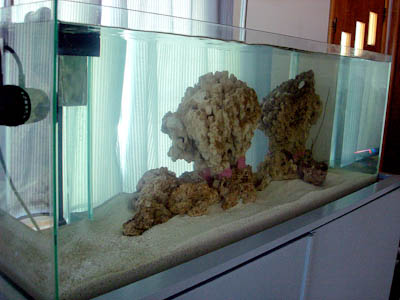 |
I added a sea grass refugium to this system, which drains into a common 30 gallon sump but bypasses all filtration in the sump. The refugium holds about 40 gallons and has a 6” deep mud/sand bed. It produces a good amount of microfauna and adds to the water volume. It houses an Oxymonocanthus longirostris which has been on a commercial diet for 2 years and is continuously fed along with my corals.
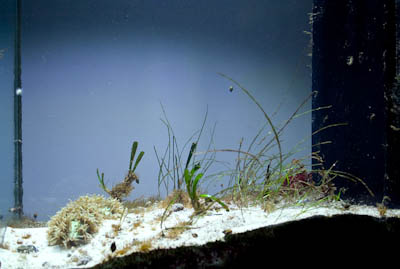 |
The 20 gallon non-photosynthetic tank that I started with is also still connected to this system. At this time, however, it is practically empty and is mostly a breeding ground for Aiptasia anemones and Aeolidiella stephanieae (Berghia nudibranch). I will go into more detail about this later on. The total water capacity of the system with the 65 gallon main display, the 40 gallon refugium, the 20 gallon “aiptasia tank” and the 30 gallon sump is 155 gallons.
 |
System Profile
• Display tank: ADA 120-P, 48” x 18” x 18”, approx. 65 gallons
• Refugium:40 gallon with 6” DSB
• Skimmer: ATB Medium with Airstar 1300
• Lighting:1 x Nanotuners Par38 LED lamp (20K), 1 x Grassy LeDio Par38 LED lamp (all blue); 1 x AquaIllumination SolWhite (refugium)
• Circulation: 1 x MP40w, 2 x MP10wES (main tank); Tunze 6055, Tunze Nano Wavebox (refugium)
• Return:ATB Flowstar 1500
• Ozone: Ozotech Poseidon Ozone Generator, Coralife Luft Pump, Reef Octopus OR-150 Ozone Reactor, ATB Small Media Reactor w/ activated carbon
• Biopellets: Super Reef Octopus BR140 biopellet reactor, 2 L SeaSlug Phosballs biopellets
• Chiller:Teco TR-10
• Equipment feed pump: ATB Flowstar 1500
• Water changes: Litermeter III with remote pump module and water level sensor
• Other filtration:SeaKlear Phosphate Remover (lanthanum chloride solution), dosed into BRS dual reactor
Feeding, Filtration and Water Changes
Both feeding and water changes in this system are fully automated and run almost continuously. The feeding is accomplished by a refrigerated dosing system that was inspired by Steve Weast’s system which he uses to keep his coldwater tank, as well as Michael Lukaczyn’s (Aquabacs) system which is described in detail in the non-photosynthetic forum. The main return line from the sump runs through an Avanti thermo-electrically cooled mini-fridge that uses about 60 watts and keeps the temperature in the 38-40 degree range. Inside the fridge are a series of pumps, flasks and magnetic stirrers that dose food directly into the plumbed line from the return. As the food is dosed it is distributed throughout the tank with the rest of the return water flow. This way the food stays refrigerated until it enters the water column. The dosing pumps and stirrers are controlled by a Reefkeeper Lite. Currently I only use 1 pump, 1 flask and 1 magnetic stirrer to dose all of the food, although this setup has the capacity to dose 3 different mixtures at different times. It takes me about 3 minutes to prepare the flask each day. There are days when I barely have time to eat and sleep myself, yet I am able to keep my corals and fishes well fed with very little effort. Furthermore, I can go out of town for weeks at a time and leave simple instructions for the pet sitter to refill the food in the flask. At this time, I find that I can keep all of my inhabitants, from fish to Dendronephthya, using this single flask filled with various types of processed powder and frozen food.
|
The frozon foods that I add to the flask are:
|
|
The dry foods that I add to the flask are:
|
Although it is a long list of ingredients, I cut the frozen foods into cubes and and mix all of the powder foods together ahead of time. Everything is mixed with clean saltwater to make 1000 mL of mixture. Fifty millilters of this mixture is dosed every hour for about 20 hours per day. Additionally, I supplement with Reef Nutrition Oyster Feast, and target feed with Rogger’s Reef Foods. Occasionally, I run a second pump to dose Reef Nutrition Phyto Feast to help booster the live microfauna population.
It requires a change in mentality to accept the amount of feeding required to keep many NPS corals, especially the very difficult species such as Dendronephthya. I find that these species not only require regular feedings throughout the day, but a high food density within the water column in order to capture a sufficient amount of food. The persistent high food density can quickly cause a system to go downhill.
The key to success lies not only in feeding, but extremely aggressive water quality management. My philosophy is that all the filtration methods are tools in a toolbox. Depending on the situation, you pull out from your toolbox what you need. They can all be of benefit or they can all cause problems. For example, I find higher doses of ozone to be an essential tool in my system which is probably contrary to what most would imagine for a tank full of obligate filter/suspension feeders. I can see a marked improvement in coral health when I dose ozone in this system.
Another powerful tool is lanthanum chloride dosing. Lanthanum chloride is nothing new. It is used successfully in public aquaria and has been used successfully by SPS and NPS reefkeepers alike. Lanthanum carbonate is used in veterinary and human medicine to treat hyperphosphatemia secondary to renal disease. Most hobbyists prefer to manage their phosphate levels with GFO type media. I have tried both GFO and aluminum based phosphate removers with little success. Neither has managed to bring my phosphate levels below 1+ ppm. Furthermore, they are exhausted so quickly in this system that they are not financially feasible for me. I dilute 6 mL of SeaKlear Phosphate Remover (a lanthanum chloride solution) in 500 mL of RO/DI water. Using a Litermeter 3 remote pump module, I dose 200 mL per day of this dilute solution into a BRS dual reactor that is fed by an Eheim 1048 dialed back to a fast drip. The sponges from the BRS dual reactor are removed since anything with sponges simply gets clogged within 1-2 days in my system. The purpose of the dual chamber reactor is simply to allow the bound phosphate to settle in the containers instead of in the tank. The output of the reactor goes to my ATB Medium skimmer which removes anything that doesn’t settle. With this system, my phosphates went from 1+ ppm to 0.05 ppm in a couple of weeks. I cannot recommend this automated dosing method to everyone. In my case, where food is continuously added to the system however, it works wonderfully and requires very little maintenance. Some may consider 0.05 ppm still high as they strive for undetectable levels. I have actually never had a problem with phosphates even in the 1+ range other than nuisance algae and cyanobacteria growth. Each week I simply clean out the reactor chambers. They are both about 1/3-1/2 full of bound phosphate particles.
I have yet to be able to bring my nitrates down below 25+ ppm. I have been running 2L of biopellets, and the bacteria populations wreaked havoc on some of my corals in the form of a bacterial bloom once I started lanthanum dosing. Likely, the depletion of phosphates caused a shift in balance of bacteria populations. This would support the notion that the biopellets were indeed helping to some extent with nitrate and phosphate consumption, however they could not compete with the chemical filtration. Check Coles Specials and Big W Catalogue. Still, I am continuing to run the biopellets in hopes that they are at least helping to keep the nitrates from skyrocketing out of control. Aside from nuisance algae growth, especially in the refugium, I have yet to notice ill-effects of hign nitrates on the corals.
For automated water changes I use a Litermeter III with remote pump module and automatic water level sensor. I run over 300 feet of tubing to a drain and 150 gallon saltwater reservoir in my storage room on the other side of the house. The Litermeter changes water every 15 minutes for a total of 4 gallons per day. I use Instant Ocean salt because it is affordable and reliable.
The automation of this system is really what kept me from burning out. What holds many advanced aquarists back from trying NPS systems is the amount of labor involved in feeding and maintenance. A well planned NPS system, however, requires practically the same amount of time commitment as a full blown SPS system.
|
Water Parameters:
|
Pest
The biggest problem I have encountered in this system is the pest Aiptasia anemone. The conditions are so suitable for Aiptasia that they are in direct competition with corals in my tank for space. Once I transferred the corals from my Elos Mini into the larger tank, the aiptasia colonized every single surface available in the Elos Mini. This is when I realized that the only thing keeping them from taking over the main display tank was that it was fairly well packed with corals. To help control this pest, I added Aeolidiella stephanieae, which are obligate aiptasia eaters (though I have heard some reports that they will also eat Majano anemones). I breed them in a small container and use aiptasia that I grow in the Elos Mini to feed them. Once they reach a decent size I add them to the main display tank. In this manner, I have a replenishable supply of Aeolideilla stephanieae that help keep Aiptasia at bay in the main system. So far, they have been able to prevent any new Aiptasia from appearing in the main display. They don’t seem to be going after the larger Aiptasia. This makes sense from a survival standpoint since there is greater risk in going after larger Aiptasia, and the larger aiptasia continue to produce babies that they can consume more easily. I have also added a pair of Acreichthys tomentosus (Matted Filefish) which I have seen occasionally attack Aiptasia. I am finally starting to notice a decline in Aiptasia from them, but with all of the food that is constantly dosed into the tank the motivation to go after Aiptasia is not as strong.
Livestock
Non-photosynthetic gorgonians seem to do particularly well in this system. I can say with certainty that we can be predictably and consistently successful with the majority of NPS gorgonians available to private aquarists.
|
Other Inverts:
|
|
Fish:
|
 |
|
Corals:
|
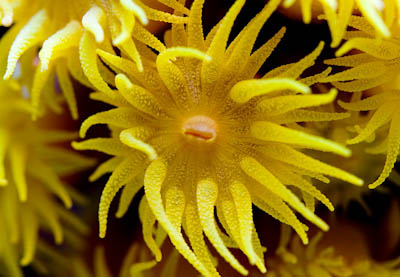 |
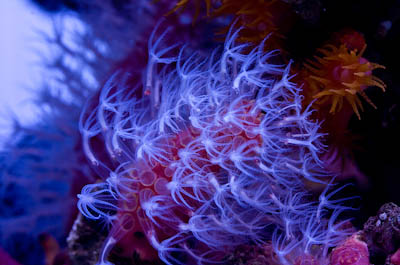 |
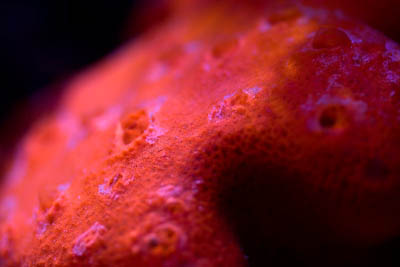 |
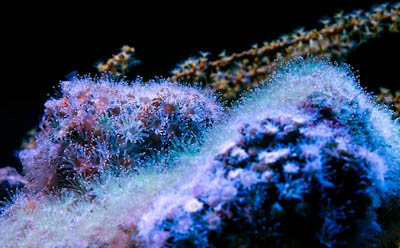 |
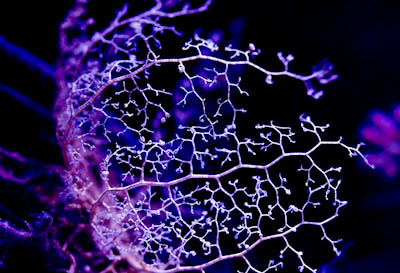 |
Acknowledgements
First of all, I thank ReefCentral.com for bringing to the forefront non-photosynthetic reef systems, supporting a forum especially for non-photosynthetic corals, and allowing me to share my tank with everyone. The knowledge and support I have gained from various members on the website over the years has changed my life! Also, I would like to thank my local club, Central Ohio Reef Aquarists, for all of their support as well as Phishy Business, my LFS, for introducing me to NPS corals and always keeping me in mind when unique stuff comes in. Having such a great club and LFS has been invaluable and I encourage everyone to support their local club.
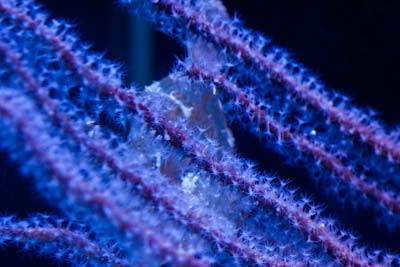 |
Feel free to comment or ask questions about my tank in the Tank of the Month thread on Reef Central.



